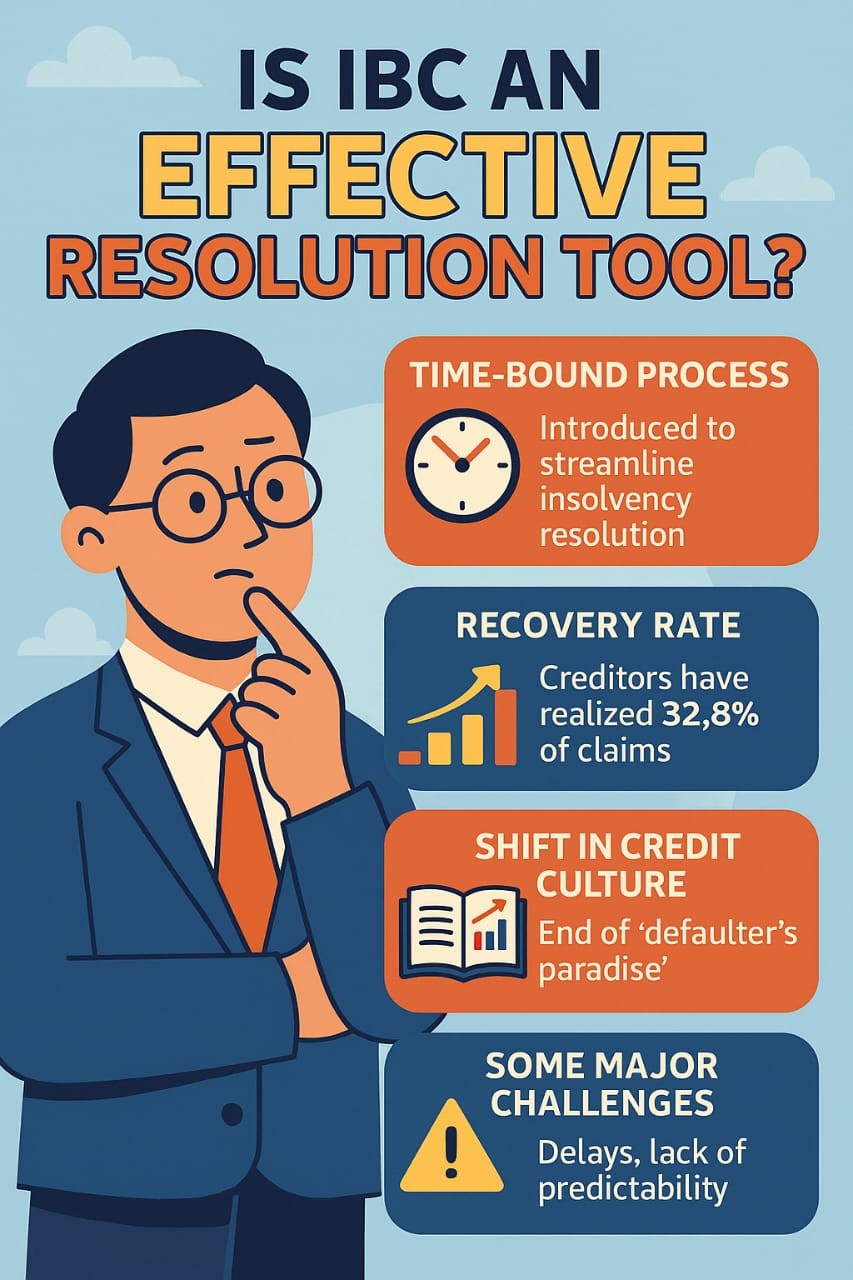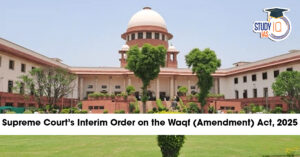Table of Contents
The implementation of the Insolvency and Bankruptcy Code (IBC), 2016, signified a pivotal change in India’s financial and economic framework. The IBC implemented a creditor-in-control paradigm, supplanting a fragmented, debtor-centric regime characterised by extensive delays. As India concludes more than eight years under this regulatory framework, it is essential to assess the effectiveness, problems, and influence of the IBC on the Indian credit ecosystem.
Genesis and Purpose of India’s Insolvency and Bankruptcy (IBC)
- The Insolvency and Bankruptcy Code (IBC) was enacted in May 2016 to unify multiple laws concerning insolvency and bankruptcy, including the Sick Industrial Companies Act of 1985 (SICA) and the Recovery of Debts Due to Banks and Financial Institutions Act of 1993.
- Its objective was to:
-
- Develop a unified framework for corporate insolvency and personal bankruptcy.
- Implement a time-sensitive procedure for addressing insolvency issues.
- Enhance the business facilitation and investment environment in India.
- Transfer authority from the delinquent debtor to a committee of creditors (CoC).
- Maximise value for all stakeholders.
- Before the IBC, India’s legal environment was inefficient, with recovery rates under 20% and delays spanning decades.
- The IBC addressed this systemic inefficiency by establishing a maximum resolution timetable of 330 days and a liquidation mechanism as a contingency plan.
Historical Context: Evolution of Bankruptcy Laws in India
- Prior to the IBC, India depended on legislation such as:
-
- The Provincial Insolvency Act of 1920 (applicable to individuals and partnerships).
- The Companies Act of 1956 (pertaining to the dissolution of companies).
- SICA, 1985, and the Board for Industrial and Financial Reconstruction (BIFR).
- These statutes were fragmented, inefficient, and frequently misapplied.
- The IBC was established to supersede many statutes, unify judicial platforms, and create a contemporary insolvency framework consistent with international standards.

Performance So Far: Facts and Figures
- The Insolvency and Bankruptcy Board of India (IBBI) states that:
- Creditors have recovered ₹3.89 lakh crore pursuant to the Code.
- The average recovery rate is 32.8% of admitted claims.
- Resolutions under the Insolvency and Bankruptcy Code (IBC) have achieved 93.41% of the fair value of Corporate Debtors (CDs).
- More than 30,000 instances were resolved before admission, with default amounts aggregating to ₹13.78 lakh crore.
- Approximately 2,758 companies were subjected to liquidation, while 1,276 instances were adjudicated via appeals, settlements, or reviews.
- According to the RBI’s 2024 report, the IBC constituted 48% of total bank recoveries in FY 2023-24, highlighting its significance in India’s debt recovery framework.
Not Just Recovery, But Resolution
- It is essential to emphasise the difference between recovery and resolution.
- The National Company Law Appellate Tribunal (NCLAT) and the Supreme Court have emphasised that the Insolvency and Bankruptcy Code (IBC) is not a recovery instrument, but rather a framework for resolving insolvency and revitalising distressed enterprises.
- The transition from a punitive to a rehabilitative strategy has fostered credit discipline.
- Akshat Khetan, a legal expert, stated that the IBC has transformed the credit culture in India by abolishing the “defaulter’s paradise“.
- The comparatively weak recovery rate must be understood in the context of the severely distressed condition of assets undergoing insolvency.
Economic Impact and Credit Culture
- A study conducted by IIM Bangalore revealed that the IBC has considerably:
- Decreased non-performing assets (NPAs), with gross NPAs declining from 11.2% in March 2018 to 2.8% in March 2024.
- Reduced the credit cost by 3% for financially troubled companies.
- Enhanced corporate governance, characterised by a rise in independent directors on the boards of resolved organisations.
- These trends show the extensive systemic advantages of the IBC beyond just numerical recovery rates.
Judicial Delays and Systemic Bottlenecks
- Notwithstanding its achievements, the IBC encounters ongoing challenges:
-
- Post-CoC approval delays at the NCLT and NCLAT.
- Extended litigation resulting in unsuccessful implementations and compelled liquidations of viable businesses.
- Requirement for enhanced management of non-traditional assets, including intellectual property and digital enterprises.
- Inadequate infrastructure and manpower within the adjudicatory bodies.
- India Ratings & Research emphasised that these systemic deficiencies undermine investor confidence and postpone final results, thereby impacting predictability and certainty.
The Bhushan Steel Verdict and Commercial Certainty
- The present case involving Bhushan Power & Steel Ltd. has generated concerns by challenging an already enacted resolution plan, so undermining the finality of commercial decisions under the IBC.
- Although judicial review is crucial, persistent interference following a resolution may dissuade investors and undermine the original purpose of the Code.
- The ruling has heightened the necessity for:
-
- Judicial clarification on the conclusiveness of approved settlement plans.
- Legal validity of commercial decisions made by the Committee of Creditors (CoC).
- Guarantee to bidders that their post-resolution investments are protected from retroactive disputes.
Revocation of President’s Rule
- President’s Rule may be revoked at any moment, particularly when:
- A new government is established with a clear legislative majority.
- Elections are held, reinstating democratic legitimacy.
- Enhanced security and law enforcement promote constitutional governance.
- Consistent with the tenets of representative democracy, revocation frequently serves as the objective, with the Union functioning as a provisional caretaker.
Role in National Resilience
- In times of economic crises, such as the COVID-19 epidemic, the IBC was provisionally suspended to prevent widespread insolvency filings.
- Notwithstanding the pause, the framework continued to be vital for strategic debt resolution upon the restoration of routine.
- It has facilitated the overarching objective of transforming India into an investment-friendly nation and achieving a $5 trillion GDP by:
-
- Facilitating expedited capital recycling.
- Restoring distressed businesses.
- Improving the stability of the financial industry.
Way Forward: Strengthening the Framework
- To transform into a genuinely efficient and future-oriented framework, the IBC must:
-
- Augment tribunal capabilities and implement digitisation.
- Promote pre-packaged insolvency arrangements.
- Elucidate the legal classification of assets inside the new economy.
- Establish legal protections to prevent excessive litigation.
- Preserve balance between judicial oversight and business acumen.
- Khetan aptly stated, “The IBC must remain nimble, continually evolving to meet emerging realities while ensuring that commercial wisdom is not second-guessed endlessly.”
- The Insolvency and Bankruptcy Code, 2016, represents a fundamental change that has markedly enhanced India’s bankruptcy framework.
- Despite ongoing issues, especially regarding delays and legal finality, the IBC has fulfilled its commitment to transform credit behaviour, strengthen creditor rights, and facilitate company continuity.
- Its efficacy is rooted not only in financial recoveries but also in fostering a responsible, creditor-aware business ethos.
- As India seeks economic growth and global competitiveness, a strong and dependable IBC framework will continue to be its foundation.


 Reserved vs General Quota: Supreme Court...
Reserved vs General Quota: Supreme Court...
 Supreme Court’s Interim Order on the W...
Supreme Court’s Interim Order on the W...



















